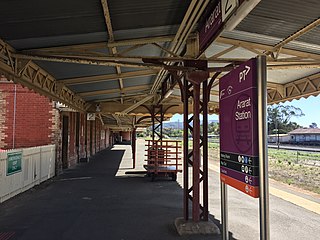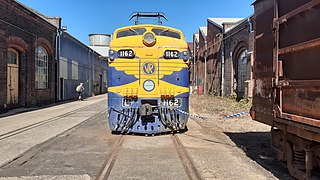Locomotives (Victorian Railways and successors)
| Image | Class | Wheel arrangement | Fleet number(s) | Manufacturer | Years in service | Number made | Number remaining | Comments |
|---|---|---|---|---|---|---|---|---|
Tank locomotives | ||||||||
| G&MR0-4-0T | 0-4-0 VBT | Ariel | Walker & Munro, Geelong | 1860–1864 | 1 | 0 |
| |
| G&MR0-6-0WT | 0-6-0 WT | 19, 21, Goliath, Samson | R&W Hawthorn 927–930 | 1860–? | 2 | 0 |
| |
| G&MR2-2-2WT | 2-2-2 WT | 34 – 40 (even only), Oberon, Sirocco, Titania, Typhoon | Robert Stephenson & Co. (2) 1006, 1007 Stothert & Slaughter, Bristol (2) | 1860–? | 4 | 0 |
| |
| G&MR2-4-0WT | 2-4-0 WT | 42, 44, Cyclone, Hurricane | R&W Hawthorn 925, 926 | 1860–? | 2 | 0 |
| |
| L class | 2-4-0 ST | 16 – 25 † L 14 – L 32 (even only) | George England & Co. (7) Slaughter, Gruning & Co. (3) | 1861–1906 | 10 | 0 |
| |
| M&HBR0-4-0WT | 0-4-0 WT | VR South Suburban system 5, 24, Pier Donkey (x2) VR Pier Donkey (x2) | Robert Stephenson & Co. 1177, 2220 | 1878–c1904 | 2 | 0 | VR South Suburban system
VR
| |
| C class | 4-4-0 WT | VR South Suburban system 1 – 4, 17, 18, 20 – 23, 25 – 38 VR C 42, C 262 – C 310 (even only) | Robert Stephenson & Co. (6) Phoenix Foundry (12) Robertson Bros. (8) | 1878–1918 | 26 | 0 | VR South Suburban system
VR
| |
| N class | 2-4-0 WT | VR South Suburban system 1, 6 – 16, 19 VR N 242 – N 260 (even only) | Robert Stephenson & Co. | 1878–1906 | 11 | 0 | VR South Suburban system
VR
| |
| M class | 4-4-0 T | 40 ‡, 210 – 238 (even only) ‡, M 40, M 210 – M 240 (even only), M 312 – M 320 (even only) | Beyer, Peacock & Co. (1) Phoenix Foundry (21) | 1879–1905 | 22 | 0 |
| |
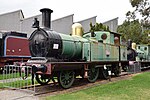 | E class | 2-4-2 T | E 12, E 34, E 36, 236, E 346 – E 394 (even only), E 426 – E 460 (even only), E 472 – E 520 (even only) | David Munro (25) Kitson & Co (1) Phoenix Foundry (45) | 1888–1931 | 71 | 1 |
|
 | EE class | 0-6-2 T | EE 34, EE 348 – EE 518 (various), EE350 – EE390 (various) §, E 350 – E 353, E 355 – E 357, E 359, E 361 – E 367, E 369 – E 381, E 390 | Phoenix Foundry (5) VR Newport Workshops (24) | 1893–1966 | 29 | 2 |
|
| Z class | 2-4-0 T | Z 522, Z 524 | Phoenix Foundry | 1893–1911 | 2 | 0 |
| |
 | Z class | 0-6-0 T | Z 526 | VR Newport Workshops | 1893–1978 | 1 | 1 | |
 | NA class | 2-6-2 T | 1 A – 17 A | Baldwin Locomotive Works (2) VR Newport Workshops (15) | 1898–1973 | 17 | 6 |
|
 | ME class | 4-4-2 T | M 40, M 210 – M 240 (even only), M 312 – M 320 (even only) | VR Newport Workshops | 1900–1922 | 22 | 0 |
|
 | class | 4-6-2 T | 701 – 721, 723 – 729 (odd only), 731 – 750, 772 – 796(even only) 250 – 287 § | VR Newport Workshops | 1908–1932 | 58 | 0 |
|
 | F class (Motor) | 2-4-2 T | F 172 – F 184 (evens only) | VR Newport Workshops | 1910–1929 | 7 | 1 |
|
 | D4 class | 4-6-2 T | D4 250 – D4 287 | VR Newport Workshops | 1929–1962 | 38 | 1 |
|
Tender locomotives | ||||||||
| No. 1 | 2-2-2 2-4-0 | 1 †, 12, 528 | George England & Co. | 1859–1890, 1893–1904 | 1 | 0 |
| |
| Old V class | 0-6-0 | 1 – 4 †, 2 – 5 †, 11 – 17 (odd only) ‡, V 11 – V 17 (odd only), 497 | George England & Co. | 1859–1904 | 4 | 0 |
| |
| J class | 2-2-2 2-4-0 | 2 – 6 †, 2 – 10 (even only) ‡, J 2 – J 10 (even only) | Beyer, Peacock & Co. | 1860–1916 | 5 | 0 |
| |
| P class | 0-6-0 | 5 – 9 †, 1 – 9 (odd only) ‡, P 1 – P 9 (odd only) | Beyer, Peacock & Co. | 1860–1921 | 5 | 0 |
| |
 | B class | 2-4-0 | 32 – 51 †, 64 – 69 †, 82 – 87 †, 46 – 96 (even only) ‡, 102 – 112 (even only) ‡, 186 ‡, 188 ‡, B 46 – B 80 (even only), B 84 – B 90 (even only), B 94, B 96, B 102 – B 112 (even only), B 186, B 188 | Beyer, Peacock & Co. (19) Phoenix Foundry (2) R&W Hawthorn (13) | 1862–1917 | 34 | 0 |
|
 | O class | 0-6-0 | 26 – 31 †, 52 – 63 †, 70 – 81 †, 88 †, 89 †, 19 – 81 (odd only) ‡, 127 – 149 (odd only) ‡, O 19 – O 81 (odd only), O 127 – O 149 (odd only) | Beyer, Peacock & Co. (11) Phoenix Foundry (7) Robert Stephenson & Co. (12) Slaughter, Gruning & Co. (6) VR Williamstown Workshops (2) Yorkshire Engine Co. (6) | 1862–1922 | 44 | 0 |
|
| No. 100 (E class) | 2-4-0 | 100 †‡, E 100, 100 | VR Williamstown Workshops | 1872–1916 | 1 | 0 |
| |
| No. 103 & 105 | 0-6-0 | 103, 105 | VR Williamstown Workshops | 1873–1924 | 2 | 0 |
| |
 | Q class | 0-6-0 | 83 – 101 (odd only) ‡, Q 83 – Q 101 (odd only) | Phoenix Foundry | 1873–1908 | 10 | 0 |
|
 | F class | 2-4-0 | 98‡ 126 – 144 (even only)‡, 166 – 184 (even only) ‡, F 98, F 126 – F 144 (even only), F 166 – F 184 (even only) | Beyer, Peacock & Co. (1) Phoenix Foundry (20) | 1874–1922 | 21 | 0 |
|
| K class | 2-4-0 | 114 – 124 (even only) ‡, K 114 – K 124 (even only) | Phoenix Foundry | 1874–1905 | 6 | 0 |
| |
 | T class | 0-6-0 | 125 ‡, 249 – 283 (odd only) ‡, T 1 – T 4, T 125, T 249 – T 283 (odd only), T 90 – T 92 §, T 94 §, T 96 § | Beyer, Peacock & Co. (6) Phoenix Foundry (18) | 1874–1953 | 24 | 1 |
|
| U class | 0-6-0 | 107 – 123 (odd only) ‡, U 107 – U 123 (odd only) | Phoenix Foundry | 1874–1908 | 9 | 0 |
| |
| G class | 4-4-0 | 38 ‡, 44 ‡, G 38, G 44 | VR Williamstown Workshops | 1877–1904 | 2 | 0 |
| |
| H class | 4-4-0 | 146 – 160 (even only) ‡, H 146 – H 160 (even only) | Phoenix Foundry | 1877–1916 | 8 | 0 |
| |
| 'Rogers' (D class) | 4-4-0 | 162, 164 | Rogers Locomotive Works | 1877–1907 | 2 | 0 |
| |
| Old R class | 0-6-0 | 151 ‡, 157 – 195 (odd only) ‡, 247 ‡, 285 – 325 (odd only) ‡, R 11, R 13, R 151, R 157 – R 195 (odd only), R 247, R 285 – R 351 (odd only), R 300 – R 347 (various) §, R 349 § | Beyer, Peacock & Co. (4) Phoenix Foundry (55) | 1879–1944 | 59 | 0 |
| |
| W class | 4-6-0 | 153 ‡, 155 ‡, 217 – 235 (odd only) ‡, W 153, W 155, W 197, W 217 – W 235 (odd only) | Baldwin Locomotive Works | 1880–1926 1933–1934 | 13 | 0 |
| |
| S class | 4-6-0 | 197 – 215 (odd only) ‡, S 197 – S 215 (odd only) | Phoenix Foundry | 1882–1908 | 10 | 0 |
| |
| 'Belgian' R class | 0-6-0 | 237 – 245 (odd only) ‡, R 237 – R 245 (odd only) | Société de Saint-Léonard | 1883–1920 | 5 | 0 |
| |
| Old A class | 4-4-0 | 190 – 208 (even only) ‡, A 190 – A 208 (even only) | Beyer, Peacock & Co. | 1884–1924 | 10 | 0 |
| |
| X class | 0-6-0 | X 353 – X 381 (odd only) | Phoenix Foundry | 1886–1920 | 15 | 0 |
| |
| D class | 4-4-0 | D 82, D 92, D 122, D 242, D 244, D 248, D 250, D 260, D 322 – D 344 (even only), D 190 §, D 191 §, D 194 § | Phoenix Foundry | 1887–1928 | 20 | 0 |
| |
| New A class | 4-4-0 | A 396 – A 424 (even only) | Phoenix Foundry | 1889–1925 | 15 | 0 |
| |
| New R class | 0-6-0 | R 447 – R 495(odd only) | Robertson Bros. | 1889–1908 | 25 | 0 |
| |
 | Y class | 0-6-0 | Y 383 – Y 441 (odd only), Y 445, Y 400 – Y 423 (various), Y 453 – Y 483 (various), Y 100 – Y 132 § | Kitson & Co. (1) Phoenix Foundry (30) ex-RY class (15) | 1889–1963 | 46 | 2 |
|
| RY class | 0-6-0 | RY 447 – RY 495(odd only) | ? | 1899–1951 | 25 | 0 |
| |
 | V class | 2-8-0 | V 499 – V 529 (odd only), V 200 – V 204 §, V 206 §, V 210 – V 215 § | Baldwin Locomotive Works (1) Phoenix Foundry (15) | 1900–1930 | 16 | 0 |
|
| | AA class | 4-4-0 | AA530 – AA558 (even only), AA562 – AA570 (even only), AA74 – AA77 §, AA82 – AA86 (even only) § | Phoenix Foundry | 1900–1932 | 20 | 0 |
|
| | DD class | 4-6-0 | DD873 – DD 912, DD 943 – DD 982, DD 1013 – DD 1052, DD 500 – DD 799 § | Baldwin Locomotive Works (20) Beyer, Peacock & Co. (20) Phoenix Foundry (7) Thompson Foundry (40) VR Ballarat North Workshops (8) VR Bendigo Workshops (8) VR Newport Workshops (138) Walkers Limited (20) ? (2) | 1902–c. 1939 | 263 | 0 |
|
 | A2 class | 4-6-0 | A2 572 – A2 1082 (various), A1 800 – A1 877 (various), A2 816 – A2 999 § | VR Ballarat North Workshops (5) VR Bendigo Workshops (5) VR Newport Workshops (175) | 1907–1964 | 185 | 5 | |
 | C class | 2-8-0 | C 1 – C 26 | VR Newport Workshops | 1918–1962 | 26 | 1 |
|
| D1 class | 4-6-0 | D1 500 – D1 703 (various) | Ex-DD class | c. 1924–1960 | 141 | 0 |
| |
 | D2 class | 4-6-0 | D2 580 – D2 604, D2 615, D2 700 – D2 799 | Ex-DD class | c. 1927–1962 | 107 | 1 |
|
 | K class | 2-8-0 | K 100 – K 109, K 140 – K 192 § | VR Newport Workshops | 1922–1979 | 53 | 21 |
|
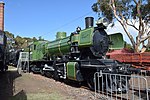 | N class | 2-8-2 | N 110 – N 139, N 400 – N 432 §, N 450 – N 499 § | North British Locomotive Company (50) VR Newport Workshops (33) | 1925–1966 | 83 | 1 |
|
| | S class | 4-6-2 | S 300 – S 303 | VR Newport Workshops | 1928–1954 | 4 | 0 |
|
 | D3 class | 4-6-0 | D3 604, D3 606 – D3 699 | VR Newport Workshops | 1929–1974 | 94 | 14 |
|
 | X class | 2-8-2 | X 27 – X 55 | VR Newport Workshops | 1929–1960 | 29 | 1 |
|
 | H class | 4-8-4 | H 220 | VR Newport Workshops | 1941–1956 | 1 | 1 |
|
 | R class | 4-6-4 | R 700 – R 769 | North British Locomotive Company | 1951–1974 | 70 | 7 |
|
 | J class | 2-8-0 | J 500 – J 559 | Vulcan Foundry | 1954–1978 | 60 | 11 |
|
Garratt locomotives | ||||||||
 | G class | 2-6-0+0-6-2 | G 41 – G 42 | Beyer, Peacock & Co. | 1926–1964 | 2 | 1 |
|
Petrol/Diesel Electric Locomotives | ||||||||
 | F class | 0-6-0 DE | F 310 – F 319, SEC 1 – SEC 6 F 201 – F 216 § | Dick, Kerr & Co. | 1951–1987 | 16 | 6 |
|
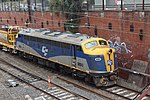 | B class | Co-Co | B 60 – B 85 | Clyde Engineering | 1952–Current | 26 | 10 |
|
 | T class | Bo-Bo | T 320 – T 413 | Clyde Engineering | 1955–Current | 94 | 36 |
|
 | S class | Co-Co | S 300 – S 317 | Clyde Engineering | 1957–Current | 18 | 12 |
|
 | Y class | Bo-Bo | Y 101 – Y 175 | Clyde Engineering | 1963–Current | 75 | 31 |
|
 | X class | Co-Co | X 31 – X 54 | Clyde Engineering | 1966–Current | 24 | 11 |
|
 | H class | Bo-Bo | H 1 – H 5 | Clyde Engineering | 1968–2020 | 5 | 4 |
|
 | C class | Co-Co | C 501 – C 510 | Clyde Engineering | 1977–Current | 10 | 10 |
|
 | A class | Co-Co | A 60 – A 85 | Clyde Engineering | 1984–Current | 11 | 5 |
|
 | G class | Co-Co | G 511 – G 543 | Clyde Engineering | 1984–Current | 33 | 31 |
|
 | P class | Bo-Bo | P 11– P 23 | Clyde Engineering | 1984–Current | 13 | 13 |
|
 | N class | Co-Co | N 451 – N 475 | Clyde Engineering | 1985–Current | 25 | 25 |
|
 | XR class | Co-Co | XR 550 – XR 559 | South Dynon Workshops | 2002–Current | 9 | 9 |
|
 | XRB class | Co-Co | XRB 560 – XRB 562 | South Dynon Workshops | 2005–Current | 3 | 3 |
|
 | VL class | Co-Co | VL351 – VL362 | Avteq | 2007–Current | 12 | 12 |
|
Petrol/Diesel Hydraulic Locomotives | ||||||||
| M class | 0-6-0 DH | M 231 – M 232 | VR Newport Workshops | 1959–? | 2 | 1 |
| |
 | W class | 0-6-0 DH | W 241 – W 267 | Tulloch Limited | 1959–1989 | 27 | 5 |
|
 | V class | 0-4-0 DH | V 56 | VR Newport Workshops | 1960–1992 | 1 | 1 |
|
Petrol/Diesel Mechanical Locomotives | ||||||||
 | RT class | 4w PM 4w DM | RT 1 – RT 54 | VR Newport Workshops | 1932–Current | 54 | ? |
|
Electric Locomotives | ||||||||
 | No. 1100 & 1101 | Bo-Bo | 1100 – 1101 | VR Newport Workshops | 1923–1954 | 2 | 0 |
|
 | E class | Bo-Bo | E 1102 – E 1111 | VR Newport Workshops & VR Jolimont Workshops | 1928–1983 | 10 | 4 |
|
 | L class | Co-Co | L 1150 – L 1174 | English Electric | 1953–1987 | 25 | 4 |
|
Other | ||||||||
| RTL class | – | RTL 1 | Western Star Trucks | 1995–Current | 1 | 1 |
| |
| Image | Class | Wheel arrangement | Fleet number(s) | Manufacturer | Years in service | Quantity made | Quantity remaining | Comments |
† Early sequential numbering
‡ Loco numbers pre class letter
§ Renumbering






